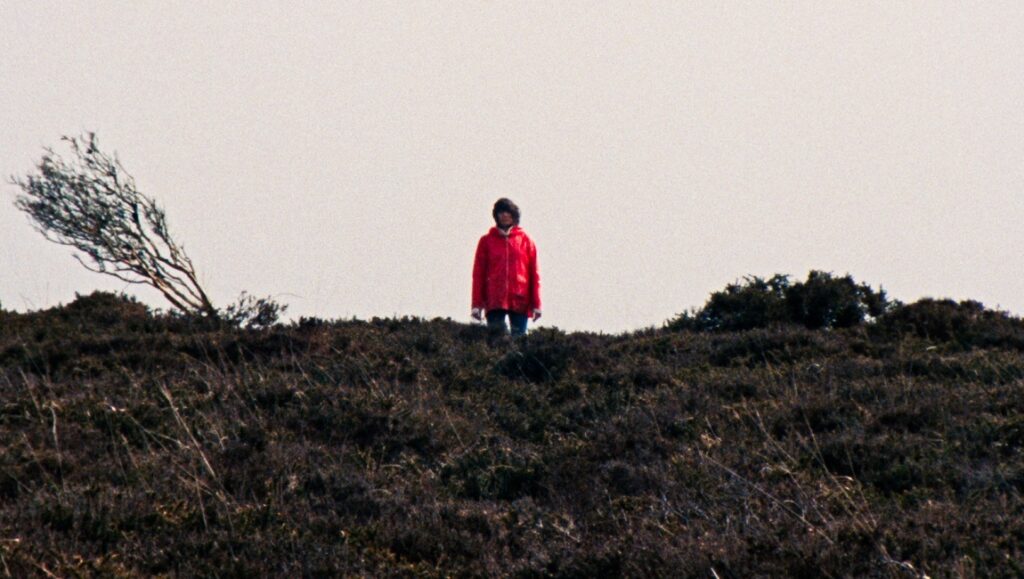In Mark Jenkin’s Enys Men, the unnamed protagonist (Mary Woodvine, in a role mysteriously dubbed “The Volunteer”) sets out on a mundane, quietly transfixing routine. Her daily tasks include observing a rare and unnamed cluster of flowers, transcribing her observations into a logbook, throwing a rock down an abandoned mineshaft, and rekindling a small petrol generator; her spare time she occupies with solitude, a book (Robert Allen and Edward Goldsmith’s A Blueprint for Survival), and a dwindling supply of tea. The setting, of course, is an equally solitudinous island off the Cornish coast in Celtic, Southwest England, and the year 1973, an era of labor strikes, global oil crisis, and domestic political conflict. These facts aren’t mere trivia: their import soon becomes clear as the film discloses — through its apparational and uneasy iconography — its broader historiographic relevance, inscribing local and national detail alike into an eerie and bedazzling (if sometimes bewildering) spectacle of folk horror.
Eerie, perhaps, best describes the manifestations of the supernatural and fantastical in Enys Men. Following Jenkin’s outstanding feature debut, 2019’s Bait — a contemporary tale of tourism and gentrification set in a Cornish fishing village — Enys Men combs through the recesses of cultural memory, this time grafting its variegated images onto a canvas distanced from Bait’s B&W, working-class realism. Where Bait was tinged with the frequently unsaid — and thus spectral — implications of its ambiguous, lo-fi narrative, Jenkin’s present invocation of Cornwall’s past ghosts acquires, especially when manifested atop a lone landscape of rock and withered foliage, a clarity that arrives ironically enough with the imposition of the uncanny. That is to say, the rhythm and tone of Enys Men are tempered by an opposition of order and disruption: order in the quotidian, almost studied patterns that constitute the Volunteer’s natural existence, and disruption in the margins of her narrative that quickly enter the forefront of her imagination and confront her shaky sense of self. Over a budding April spring, stretching into diurnal summer, the island’s untamed natural environs begin to exert a spiritual and even sensual pressure upon the Volunteer, with her background and psychology not so much explicated as they are increasingly refracted through a prism of persistent, oneiric symbolism.
Time and space are made slippery on Stone Island — a direct translation from the eponymous Cornish habitat — as various anachronistic artifacts pop up, sometimes on the periphery, other times jutting into the screen as candidly as daylight. In one sequence, a man’s visage suddenly fills the frame, as counterpoint to the Volunteer’s weathered one; in several others, a young woman — her daughter? her younger self? — flits about the stony cottage, appearing to coexist with the Volunteer. These phantasmagoria, however, do not inflict shock or awe in the traditional sense. Their lasting power derives instead from what might be psychoanalytically termed Unheimlichkeit, an inexplicable foreignness amidst rustic, private territory which reverberates across shots and coalesces in blurry, otherworldly wonder. Observing the robust evolution of 1970s British horror, from which Enys Men no doubt draws inspiration, the late Mark Fisher wrote of eeriness as that which is “constituted by a failure of absence or by a failure of presence,” a phenomenon doubly integrated into this film’s DNA. On one hand, presence refuses to show when we witness, in intimate detail, the Volunteer’s habits but not her motivations; who she is and what she does exactly are elided like ciphers from a long-buried canister. On the other hand, the solitary landscape gets disturbed, as if part of its design, by the traces of civilizational history, its class struggles and traumas come to life in the hallucinations the Volunteer experiences. Perhaps they aren’t hallucinations after all: the textured 16mm film seems to embed in them a tactility that foregrounds them in coterminous presence with her contemporary figure. Bal maidens serenade the Volunteer in repose; children frolic and merrily sing; the earthy, soot-ridden faces of long-dead miners pop up one inexplicable night, only to be then elided for the short-lived normalcy of day.
This coterie of allusions and culturally specific references in Enys Men may be easily lost on most viewers, even those with some acquaintance with the seminal works of British horror. And the film’s stubborn abstractions threaten, at times, to withdraw from classical cinematic logic in pursuit of an elusive, insular wavelength. Despite this, the irresistible pull of the fragmented para-narrative holds our attention, thwarting ready-made preconceptions of the romanticized wilderness yet colluding perversely with our inherent fascination with horror to sustain attachment to them. Jenkin’s avant-garde sensibilities are neither gaudy nor academic, reveling instead in the poetically arcane: more than anything, his film resembles a palimpsest of discrete yet interwoven impressions, of the supernatural inflected with the political and vice versa. Atop the isle, a stone menhir presides over night and day with ominous significance, its jagged body a site of tradition and lore. Enys Men similarly stands proud and alone on solemn ground, overlooking an eerie, elaborate shore.
Published as part of InRO Weekly — Volume 1, Issue 13.


Comments are closed.